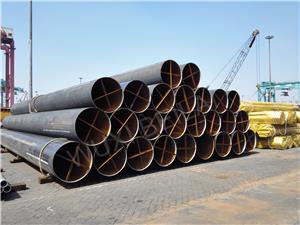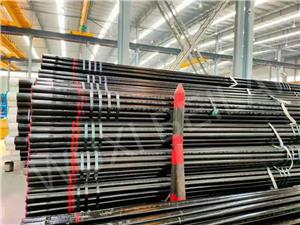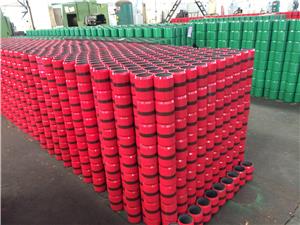BEILAI Guide to Line Pipe End Connection Types: Strong, Safe, and Project-Ready
As a dedicated supplier, BEILAI helps you choose the right line pipe ends for reliable construction, fast installation, and life-cycle value.
In this guide:
Why End Connections Matter in Line Pipe
End preparation is not an afterthought—it is a primary performance lever for line pipe. The ends determine how each section joins in the field, the speed of construction, the integrity of the seal under pressure and temperature changes, and even how easily a pipeline can be inspected or disassembled. Different line pipe end connection types support different assembly methods—welding, threading, grooving, flanging, or mechanical coupling—each tuned to specific media, pressures, and site realities.
Reliability under load
Correctly prepared ends help joints resist internal pressure, vibration, bending, and thermal cycles, keeping line pipe safe and stable.
Installation speed
Some line pipe end connection types allow rapid assembly with minimal hot work—ideal for brownfield upgrades or tight shutdown windows.
Lifecycle economics
Smart choices up front reduce weld repairs, leak risks, corrosion at joints, and long-term maintenance on critical line pipe assets.
Overview of the Major Line Pipe End Connection Types
Below, BEILAI outlines the most used line pipe end connection types, how they work, and where they shine. Whether you are building a cross-country trunk line or a plant utility loop, matching the end to the application is essential.
1) Plain End (PE)
A Plain End is a square-cut end with no bevel, thread, or groove. It offers maximum flexibility: contractors can bevel in the field for welding, apply a mechanical coupling, or fit a socket weld or compression sleeve depending on the line pipe size and service. PE ends reduce fabrication lead time when project teams finalize jointing methods later.
Best for: Flexible projects, temporary lines, and sites with mixed jointing on the same line pipe run.
Considerations: Field prep quality control is crucial to avoid misalignment or thin-land bevels during later welding.
2) Beveled End (BE) for Butt Welding
Beveled Ends are the backbone of welded line pipe construction. The common 30° bevel with a defined root face and root gap allows a full-penetration butt weld. This option supports automated welding, strong girth joints, and excellent pressure containment.
Best for: Cross-country pipelines, high-pressure transmission line pipe, and buried services where leak-tight welding is mandatory.
Considerations: Requires qualified weld procedures, welder performance qualification, and NDE to ensure uniform quality.
3) Threaded & Coupled (T&C)
Threaded and coupled ends use tapered threads with a coupling to join line pipe quickly without welding. They are common in small-diameter utility and low-pressure systems where speed matters. Proper thread sealants and torque control are essential.
Best for: Small-bore process utilities, instrument air, water lines, and quick tie-ins on line pipe manifolds.
Considerations: Thread galling, make-up torque, and sealant compatibility with media and temperature.
4) Grooved End (Roll or Cut Groove)
Grooved ends allow clamp-style mechanical couplings to join line pipe with minimal hot work. The coupling housing and gasket create a reliable seal and permit limited angular deflection and expansion. This is a favorite in plants where shutdowns are short and reroutes are frequent.
Best for: Fire protection, HVAC, chilled water, utility line pipe, and retrofit environments.
Considerations: Groove dimensions must match the coupling standard; gasket material must suit media and temperature.
5) Socket Weld End
Socket weld ends accept a pipe into a fitting’s socket and use a fillet weld to secure the joint. This method supports higher pressures than threads for small diameters while avoiding a full butt weld on thin wall line pipe.
Best for: Small-bore high-pressure line pipe in clean services where precise alignment and compact joints are needed.
Considerations: Leave expansion gap before welding; avoid in cyclic thermal service where crevice corrosion could develop.
6) Flanged End
Flanged ends add bolted flanges to the line pipe, enabling fast assembly, easy valve integration, and straightforward maintenance. Different facing types (RF, RTJ) and gasket classes offer pressure-temperature versatility.
Best for: Skid connections, equipment nozzles, and locations requiring frequent disassembly on line pipe.
Considerations: Correct bolt stress, gasket selection, and flange alignment are critical to avoid leaks.
7) Mechanical/Compression Connector End
Compression sleeves, swage fittings, and proprietary mechanical connectors make fast, weld-free joints. They are valuable for emergency repairs or when hot work is restricted. In many utilities, these connectors keep line pipe uptime high with minimal crew size.
Best for: Temporary bypasses, maintenance patches, and utility line pipe upgrades.
Considerations: Verify pressure rating, temperature limits, and compatibility with pipe OD tolerances.
8) Lined/Clad End Considerations
When line pipe is CRA-lined or clad for corrosion resistance, end prep must protect the corrosion barrier. Weld overlays, buttering layers, and special bevels ensure the joint’s corrosion performance matches the base run pipe.
Best for: Sour service, produced water, corrosive chemicals in line pipe.
Considerations: Procedure qualification addressing dilution, heat input, and post-weld cleanup of corrosion-resistant layers.
Comparison of Line Pipe End Connection Types
| End Type | Assembly Method | Speed | Pressure Capability | Reusability | Typical Uses |
|---|---|---|---|---|---|
| Plain End (PE) | Field-bevel or fit to coupling | Medium (depends on method) | High (if welded) | High (before final joint) | Mixed line pipe strategies, flexible jobs |
| Beveled End (BE) | Butt weld | Medium | Very High | Low | Transmission line pipe, buried service |
| Threaded & Coupled | Thread engagement + sealant | High | Medium (small-bore) | Medium | Utility line pipe, low-pressure loops |
| Grooved | Clamp coupling with gasket | Very High | Medium | High | Fire protection, plant utilities |
| Socket Weld | Fillet weld at socket | Medium | High (small-bore) | Low | Compact small-bore line pipe |
| Flanged | Bolting with gasket | High (prefab) | High | High | Equipment tie-ins on line pipe |
| Mechanical/Compression | Cold work clamp/insert | Very High | Medium | Medium | Repairs, no-hot-work areas |
Tip: When uptime and speed outrank ultimate pressure, grooved and mechanical line pipe options shine. For highest integrity in transmission pipelines, beveled butt-welded ends remain the gold standard.
How BEILAI Helps You Select the Right End for Your Line Pipe
Choosing among line pipe end connection types is about aligning risk, schedule, and lifetime cost. At BEILAI, we work from the application backward:
Media & corrosion profile: Gas, crude, water, chemicals—each influences gasket materials, weld metal, and whether the line pipe needs CRA lining or special end prep.
Pressure & temperature: Define wall thickness, end type, and whether welding or mechanical joints fit the duty cycle.
Construction environment: Space, hot-work restrictions, access windows, and crew skills all steer end choice on line pipe.
Inspection & maintenance: If disassembly is frequent, flanged or grooved line pipe connections save time; if permanence matters, BE welds are ideal.
Total installed cost: We compare equipment, labor, QA/NDE, and shutdown impacts—not just material price—across candidate line pipe end connection types.
Application Snapshots
Cross-country gas transmission: Beveled ends with automatic welding for high-productivity girth welds on line pipe.
Refinery utility loops: Grooved ends for fast install, minimal hot work, and easy rerouting of line pipe.
Skid tie-ins: Flanged line pipe ends for valves, meters, and equipment nozzles.
Small-bore high-pressure service: Socket-weld ends where threads would be a weak point on line pipe.
Brownfield repairs: Mechanical connectors to restore integrity when hot work is limited on existing line pipe.
Specification, Inspection, and QA for Line Pipe End Connection Types
To make sure your line pipe installs right the first time, BEILAI integrates end-to-end quality into supply. That includes dimensional control of cuts and bevels, cleanliness standards, end caps, and tailored packaging to protect line pipe ends during transit.
Key Checkpoints
Dimensional accuracy: OD, wall, out-of-roundness, cut squareness, bevel angle, land, and root radius for welded line pipe.
Surface condition: Burr-free threads/grooves; no lamination, tears, or heat tint that would compromise line pipe joints.
Materials & traceability: MTRs tied to each line pipe length; heat numbers on stencils and barcodes.
Coating interface: Field-joint coating windows sized and masked to keep line pipe ends weld-ready and clean.
NDE & pressure tests: As required by project spec for the selected line pipe end connection types.
Packaging & Handling
End protectors, dunnage, and lift points are engineered to prevent ovality and damage so your line pipe joints fit up smoothly in the right-of-way or shop.
FAQs: Line Pipe End Connection Types
Which end is most common for long distance pipelines?
Beveled butt-weld ends dominate high-pressure transmission line pipe due to strength, leak tightness, and suitability for automated welding.
When do grooved ends beat flanged ends?
In utility services where rapid changes and limited hot work are priorities, grooved line pipe connections install faster and allow controlled flexibility, while flanges suit equipment tie-ins and frequent disassembly.
Are threaded ends reliable for process media?
Yes—for small diameters and moderate pressures. Proper thread form, sealant choice, and torque are essential to keep line pipe joints leak-free.
What about corrosion at joints?
Material selection, compatible gaskets, weld procedures, and field-joint coatings are critical. For corrosive service, consider CRA-lined or clad line pipe with tailored end preparations.
Can BEILAI customize ends per project spec?
Absolutely. BEILAI supplies PE, BE, T&C, grooved, socket-weld, flanged, and mechanical-connector ready line pipe, plus special bevels, overlays, and packaging to match your line pipe end connection types and construction strategy.




